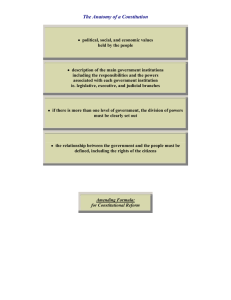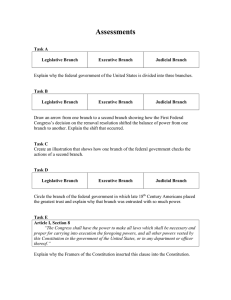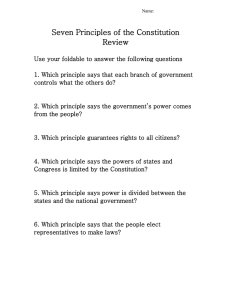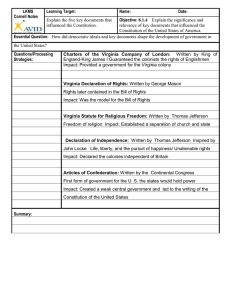Civics & Economics SOL Review KEY
advertisement
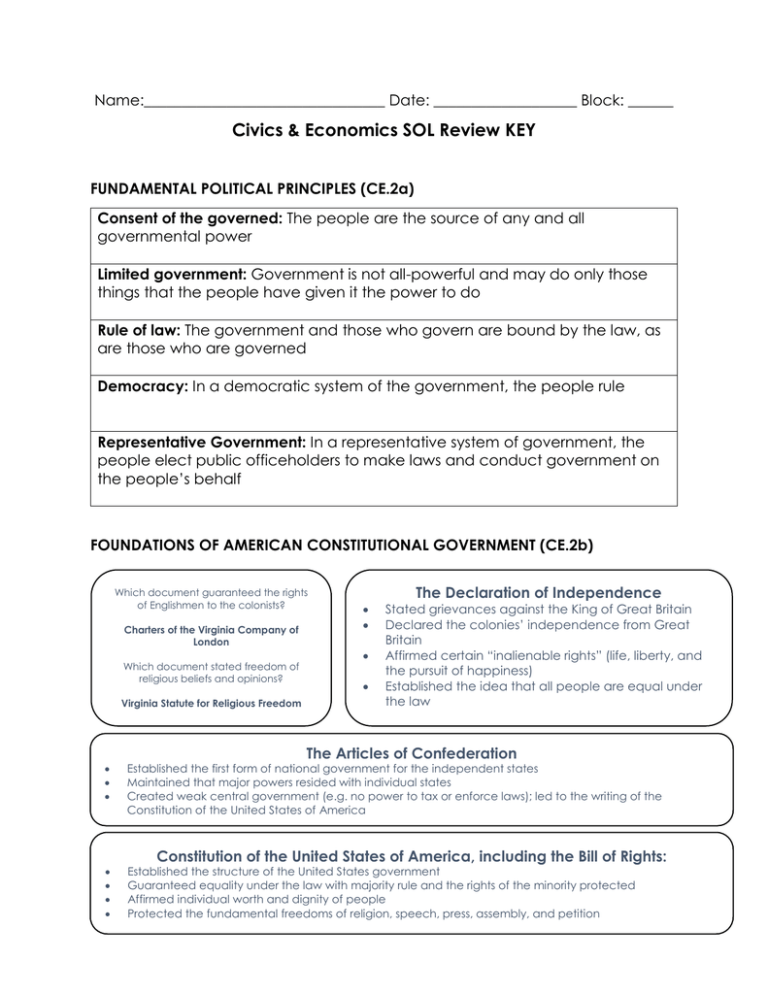
Name:________________________________ Date: ___________________ Block: ______ Civics & Economics SOL Review KEY FUNDAMENTAL POLITICAL PRINCIPLES (CE.2a) Consent of the governed: The people are the source of any and all governmental power Limited government: Government is not all-powerful and may do only those things that the people have given it the power to do Rule of law: The government and those who govern are bound by the law, as are those who are governed Democracy: In a democratic system of the government, the people rule Representative Government: In a representative system of government, the people elect public officeholders to make laws and conduct government on the people’s behalf FOUNDATIONS OF AMERICAN CONSTITUTIONAL GOVERNMENT (CE.2b) Which document guaranteed the rights of Englishmen to the colonists? Charters of the Virginia Company of London Which document stated freedom of religious beliefs and opinions? Virginia Statute for Religious Freedom The Declaration of Independence Stated grievances against the King of Great Britain Declared the colonies’ independence from Great Britain Affirmed certain “inalienable rights” (life, liberty, and the pursuit of happiness) Established the idea that all people are equal under the law The Articles of Confederation Established the first form of national government for the independent states Maintained that major powers resided with individual states Created weak central government (e.g. no power to tax or enforce laws); led to the writing of the Constitution of the United States of America Established the structure of the United States government Guaranteed equality under the law with majority rule and the rights of the minority protected Affirmed individual worth and dignity of people Protected the fundamental freedoms of religion, speech, press, assembly, and petition Constitution of the United States of America, including the Bill of Rights: PREAMBLE (CE.2c) The Preamble to the Constitution of the United States of America expresses the reasons the constitution was written. To form a more perfect union The Preamble to the Constitution of the United States of America begins, “We the People,” thereby establishing that the power of government comes from the people. To secure the blessings of liberty Purposes of the United States Government To establish justice To promote the general welfare To ensure domestic tranquility To provide for the common defense AMENDING THE CONSTITUTIONS OF VIRGINIA AND THE UNITED STATES (CE.2d) Constitution of Virginia Amendment Process o Proposal: action by General Assembly or convention o Ratification by voters of Virginia Constitution of the U.S. The Amendment process is complex To date, there are 27 amendments Amendment process: o Proposal: action by Congress or convention o Ratification: by the states PROCESSES TO BECOME A UNITED STATES CITIZEN (CE.3a) The Fourteenth Amendment to the Constitution of the United States of America defines citizenship as follows: “All persons born or naturalized in the United States, and subject to the jurisdiction thereof, are citizens of the United States and the state wherein they reside.” The Fourteenth Amendment extends the due process protection to actions of the states Immigration and naturalization, particularly in the twentieth century, have led to an increasingly diverse society. To become a citizen though naturalization, a person must demonstrate knowledge of American history and principles and the ability to read, speak, and write words in ordinary usage in the English language. Mean of obtaining citizenship: o Birth o Naturalization FIRST AMENDMENT FREEDOMS (CE.3b) Religion Government may not establish an official religion, or unduly interfere with the free exercise of religion Petition Speech Individuals have the right to make their views known to public officials Individuals are free to express their opinions and beliefs Assembly Individuals may peacefully gather First Amendment Freedoms Press The press has the right to gather and publish information, including that which criticizes the government DUTIES OF CITIZENS (CE.3c) Duties of Citizens Serve on a jury or as a witness in court, when summoned Obey laws Pay taxes Serve in the armed forces, if called Citizens who choose not to fulfill these civic duties face legal consequences. RESPONSIBILITIES OF CITIZENS (CE.3d) Responsibilities of Citizens Civic responsibilities are fulfilled by choice: they are voluntary. Communicate with government officials to influence government actions Register and vote Participate in political campaigns Serve in voluntary, appointed government positions Hold elective office Respect others’ right to an equal voice in government Keep informed regarding current issues ADDRESSING COMMUNITY NEEDS AND SERVING THE PUBLIC GOOD (CE.3e) Ways for Citizens to Participate in Community Service Volunteer to support democratic institutions (e.g., League of Women Voters) Express concern about the welfare of the community as a whole (e.g., as related to environment, public health and safety, education) Help to make the community a good place to work and live (e.g., by becoming involved with public service organizations, tutoring, volunteering in nursing homes). TRAITS OF GOOD CITIZENS (CE.4) Effective Participation in Civic Life Can Include: Personal Traits of Good Citizens: Trustworthiness and honesty Courtesy and respect for the rights of others Responsibility, accountability, and selfreliance Respect for the law Patriotism Participation in school and/or local community Participation in elections as an informed voter Formulating questions Analyzing information from a variety of sources Expressing a position Devising and implementing a plan Practicing thoughtful decision making in personal, financial, and civic matters (e.g., voting, civic issues). FUNCTIONS OF POLITICAL PARTIES (CE.5a) Recruiting and nominating candidates Educating the electorate about campaign issues Functions of Political Parties Monitoring actions of officeholders Helping candidates win elections SIMILARITIES AND DIFFERENCES OF POLITICAL PARTIES (CE.5b) Similarities Between Parties Organize to win elections Influence public policies Reflect both liberal and conservative views Define themselves in a way that wins majority support by appealing to the political center Differences Between Parties Stated in party platforms and reflected in campaigning Third Parties Introduce a new idea and/or press for a particular issue Often revolve around a political personality (e.g., Theodore Roosevelt) CAMPAIGNS AND MEDIA (CE.5c) Strategies for evaluating campaign speeches, literature, and advertisement for accuracy Separating fact from opinion Detecting bias Evaluating sources Identifying propaganda Identifying candidates Emphasizing selected issues Writing editorials, creating political cartoons, publishing oped pieces Broadcasting different points of view Mass media roles in elections CAMPAIGN CONTRIBUTIONS AND COSTS (CE.5d) Rising Campaign Costs Require candidates to conduct extensive fund-raising activities Limit opportunities to run for public office Give an advantage to wealthy individuals who run for office Encourage the development of political actions committees (PACs) Give issue-oriented special interest groups increased influence Campaign Finance Reform Rising campaign costs have led to efforts to reform campaign finance laws Limits have been placed on the amount individuals may contribute to political candidates and campaigns VOTER REGISTRATION AND PARTICIPATION (CE.5e) Only citizens who register may participate in primary and general elections. Qualifications to register to vote in Virginia: Citizen of the United States Resident of Virginia and precinct At least 18 years of age by day of general election Voter registration is closed 22 days before elections. How to register to vote in Virginia: In person at the registrar’s office, as the Division of Motor Vehicle, or at other designated sites By mail-in application Factors in prediction which citizens will vote: Education Age Income Reasons why citizens fail to vote: Lack of interest Failure to register The percentage of voters who participate in presidential elections is usually greater than the percentage of voters who participate in state and local elections. Every vote is important. ELECTORAL COLLEGE (CE.5f) Electoral College Process: A slate of electors for each state is chosen by popular vote Most states have a winner-take-all system The electors meet to vote for president and vice president The winner-take-all system leads to the targeting of densely populated states for campaigning, although candidates must pay attention to less populated states whose electoral votes may make the difference in tight elections. The number of electors of each state is based on the size of the state’s Congressional representation, which is based on the state’s population. The requirement for a majority vote to win in the Electoral College favors a two-party system. STRUCTURE AND POWERS OF THE NATIONAL GOVERNMENT (CE.6a) Legislative, executive, and judicial powers of the national government are distributed among three distinct and independent branches of government. Legislative Branch Consists of Congress, a bicameral legislature consisting of the House of Representatives (435 members, based on populations of the states), and the Senate (100 members – two per state) Makes the laws of the nation Approves the annual budget Confirms presidential appointments Raises revenue through taxes and other levies Regulates interstate and foreign trade Declares war Executive Branch Headed by the president of the United States, the chief executive officer of the nation Executes the laws of the land Prepares the annual budget for congressional action Appoints cabinet officers, ambassadors, and federal judges Administers the federal bureaucracy Judicial Branch Consists of the federal courts, including the Supreme Court, the highest court in the land The Supreme Court exercises the power of judicial review The federal courts try cases involving federal law and questions involving interpretation of the Constitution of the United States SEPARATION OF POWERS AND CHECKS AND BALANCES (CE.6b) Separation of Powers The Constitution of the United States in Articles I, II, and III defines the powers of the legislative, executive, and judicial branches of the national government. Legislative Branch The Congress checks the president when legislators: Override presidential vetoes Impeach and convict a President The Congress checks the courts when legislators: Confirm or refuse to confirm judges/justices Impeach and convict judges / justices Checks and Balances Each of the three branches of the national government limits the exercise of power by the other two branches. Executive Branch The President checks Congress when he/she: Proposes legislation Prepares an annual budget for Congress to approve Calls special sessions of Congress Vetoes legislation that Congress has passed The President checks the courts when he/she appoints judges / justices. Judicial Branch The courts check Congress when judges / justices declare acts of Congress to be unconstitutional. The courts check the president when judges / justices declare executive actions to be unconstitutional. LAWMAKING PROCESS (CE.6c) Legislative Powers The law making process in Congress: Introducing a bill by a Senator or Representative Working in committees Debating the bill on the floor of each house Voting on the bill in each house Sending the bill to the president to sign into law Expressed: Specifically listed in the Constitution Implied: Used to carry out expressed powers Elected officials in Congress write laws and take action in response to problems or issues. Individuals and interest groups help shape legislation. The formal powers of Congress are limited by the Constitution of the United States. ROLES AND POWERS OF THE EXECUTIVE BRANCH (CE.6d) Cabinet departments, agencies, and regulatory groups interpret and execute the laws. Ways the Executive Branch Influences Policymaking Proposing legislation in an annual speech to Congress (State of the Union Address) Presidential power has grown in the years since the Constitution was ratified. Appealing directly to the people Approving or vetoing legislation Appointing officials who carry out the laws The President Exercises Power As… Chief of State Chief Executive Chief Legislator Ceremonial head of the government Head of the executive branch of government Proposer of the legislative agenda Commander-inChief Head of the nation’s armed forces Chief Diplomat Chief of Party Chief Citizen Architect of American foreign policy Leader of the political party that controls the executive branch Representative of all of the people STRUCTURE AND POWERS OF THE STATE GOVERNMENT (CE.7a) The Virginia Constitution distributes power among the legislative, executive, and judicial branches of the state government. The legislative branch is the General Assembly, a bicameral legislature – the House of Delegates and the Virginia Senate – that meets annually for a fixed number of days. The executive power is exercised by the governor, who is elected for a four-year term of office. The governor appoints members of the cabinet, who oversee specific functions of government. The lieutenant governor and the attorney general are executive branch officers who are elected for a four-year term of office. The judicial power is exercised by a court system that consists of four levels of courts: Supreme Court Court of appeals Circuit courts District courts o Including small claims courts and juvenile and domestic relations courts FEDERALISM (CE.7b) The Constitution of the United States of America establishes a federal form of government in which the national government is supreme. The Constitution of the United States of America denies certain powers to both the national and state governments. The powers not given to the national government by the Constitution of the United States of America are reserved to the states. Tensions exist when federal mandates require state actions without adequate funding. Primary Responsibilities of Each Level of Government National: Conducts foreign policy, regulates commerce, and provides for the common defense State: Promotes public health, safety, and welfare STATE LAWMAKING PROCESS (CE.7c) The lawmaking process in the Virginia General Assembly: Introducing a bill Working in committees Debating the bill on the floor of each house Voting on the bill in each house Sending the bill to the governor to sign into law Elected officials in the Virginia General Assembly write laws and take action in response to problems or issues. Individuals and interest groups help shape legislation. Education To promote an informed citizenry (i.e. establish minimum standards for local schools) Public Health Revenue To level and collect taxes State Budget To approve a biennial (two year) budget prepared by the governor Primary Issues in the Legislative Process at the State Level To promote and protect the health of its citizens (i.e., fund health benefits) Environment To protect natural resources (i.e., improve water quality in the Chesapeake Bay) STATE EXECUTIVE BRANCH (CE.7d) The governor of Virginia exercises the formal powers granted by the Virginia Constitution. Chief legislator Chief of State In carrying out both the formal and informal powers of the office, the governor fills several roles including: Chief administrator Party chief Commanderin-chief Cabinet secretaries and departments, agencies, commissions, and regulatory boards: Administer laws Enforce laws Regulate aspects of business and the economy Provide services STRUCTURE AND POWERS OF THE LOCAL GOVERNMENT (CE.8a) The units of local government in Virginia are counties, towns, and cities. Local governments exercise legislative, executive, and judicial powers. Each Virginia county has an elected board of supervisors, which exercises legislative powers, enacting ordinances (local laws) and adopting an annual budget. Each Virginia county and city has an elected or appointed school board, which oversees the operation of the K-12 public schools in the county or city. Each Virginia incorporated town has an elected town council, which exercises legislative powers, enacting ordinances and adopting an annual budget. A mayor is elected either by the voters or the city council members. Each Virginia city has an elected city council, which exercises legislative powers, enacting ordinances and adopting an annual budget. A mayor is elected either by the voters or the city council members. In Virginia counties, towns, and cities, a manager may be hired by the elected legislative branch to oversee the operations of the local government. In every Virginia locality, state courts resolves judicial disputes. Judges of the circuit courts, district courts, juvenile and domestic relations courts, and small claims courts hear cases in each locality. The Virginia Constitution requires that voters in every locality elect a sheriff, a clerk of the circuit court, a commissioner of revenue, and a treasurer. Virginia local governments exercise defined and limited powers, including the power to: Enforce State and Local Laws Promote Public Health Protect the Environment Protect Public Safety Regulate Land Use Educate Children Levy and Collect Taxes LOCAL TO STATE GOVERNMENT (CE.8b) All powers of local governments in Virginia are given to them by the Constitution of Virginia and acts of the General Assembly. Not all counties and cities are given the same powers. Cities have charters listing their powers. LOCAL LAWMAKING PROCESS (CE.8c) An elected board of supervisors is the local legislative body in counties and is responsible for the passing laws (ordinances) for the county. An elected council is the local legislative body in independent cities and incorporated towns. Individuals can have the greatest influence on the decisions made by local government officials. MEDIA, PUBLIC OPINION, & PUBLIC POLICY (CE.9a) Offering a forum in which opposing viewpoints are communicated Focusing public attention on selected issues Ways the media play an important role in setting the public agenda: Government officials use the media to communicate with the public. Holding government officials accountable to the public INDIVIDUALS AND INTEREST GROUPS ON PUBLIC POLICY (CE.9b) Lobbying Seeking to influence legislators to introduce or vote for or against a bill Ways Interest Groups Influence Public Policy: Identifying issues Making political contributions Lobbying government officials Ways Individuals Influence Public Policy: Participating in politics (voting, campaigning, seeking office) Expressing opinions (lobbying, demonstrating, writing letters) Joining interest groups INTERNATIONAL ISSUES AND LOCAL DECISION-MAKING (CE.9c) Public health concerns in the event of a pandemic Policies to protect the environment (e.g., wildlife protection) International issues and events that would require policy decisions by local government officials could include the following: Economic development policies in response to the emerging global economy Public safety in the event of an act of terrorism UNITED STATES JUDICIAL SYSTEM (CE.10a) The United States has a court system whose organization and jurisdiction are derived from the Constitution of the United States and federal laws. U.S. Supreme Court: Justices, no jury; appellate jurisdiction; limited original jurisdiction U.S. Court of Appeals: Judges, no jury; appellate jurisdiction U.S. District Court: Judge, with or without jury; original jurisdiction Virginia, like each of the other 49 states, has its own separate court system whose organization and jurisdiction are derived from Virginia’s constitution and state laws. Virginia Supreme Court: Justices, no jury; appellate jurisdiction; limited original jurisdiction Court of Appeals of Virginia: Judges, no jury, appellate jurisdiction to review decisions of circuit courts Circuit court: Judge, with or without jury; original jurisdiction for felony criminal cases and for certain civil cases; appellate jurisdiction from district courts General district court, and juvenile and domestic relations court: Judge, no jury; original jurisdiction for misdemeanors in civil cases generally involving lower dollar amounts and original jurisdiction in juvenile and family cases JUDICIAL REVIEW (CE.10b) Judicial Review The supreme courts of the United States and Virginia determine the constitutionality of laws and acts of the executive branch of government. Marbury v. Madison Established the principle of judicial review at the national level. The Constitution of the United States of America is the supreme law of the land. State laws must conform to the Virginia and United States constitutions. CIVIL AND CRIMINAL CASES (CE.10c) Criminal Case In a criminal case, a court determines whether a person accused of breaking the law is guilty or not guilty of a misdemeanor or a felony. Civil Case In a civil case, a court settles a disagreement between two parties to recover damages or receive compensation. Procedure for criminal cases: A person accused of a crime may be arrested if the police have probable cause The accused may be committed to jail or released on bail The case proceeds to an arraignment where probable cause is reviewed, an attorney may be appointed for the defendant, and a plea is entered A court date is set, and a trial is conducted A guilty verdict may be appealed Procedure for civil cases: The plaintiff files a complaint to recover damages or receive compensation. Cases can be heard by a judge or a jury. Cases can be appealed. DUE PROCESS PROTECTIONS (CE.10d) Due process of law: The constitutional protection against unfair governmental actions and laws Due process protections: The 5th Amendment prohibits the national government from acting in an unfair manner The 14th Amendment prohibits state and local governments from acting in an unfair manner The Supreme Court has extended the guarantees of the Bill of Rights, based upon the due process clause. ECONOMIC CONCEPTS (CE.11a) Scarcity Resources The inability to satisfy all wants at the same time. All resources and goods are limited. This requires that choices be made. Factors of production that are used in the production of goods and services. Types of resources are natural, human, capital, and entrepreneurship. Choice Opportunity Cost Selection of an item or action from a set of possible alternatives. Individuals must choose or make decisions about desired goods and services because these goods and services are limited. What is given up when a choice is made – i.e., the highest valued alternative is forgone. Individuals must consider the value of what is given up when making a choice. Price Incentives Amount of money exchanged for a good or service. Interaction of supply and demand determines price. Price determines who acquires goods and services. Things that incite or motivate. They are used to change economic behavior. Supply and Demand Production Interaction of these two determines price. Demand is the amount of a good or service that consumers are willing and able to buy at a certain price. Supply is the amount of a good or service that producers are willing and able to sell at a certain price. Combining of human, natural, capital, and entrepreneurship resources to make goods or provide services. Resources available and consumer preferences determine what is produced. Consumption Using of goods and services. Consumer preferences and price determine what is purchased and consumed. TYPES OF ECONOMIES (CE.11b) Traditional Economy Economic decisions are based on custom and historical precedent. People often perform the same type of work as their parents and grandparents, regardless of ability or potential Mixed Economy Individuals and businesses are owners and decision makers for the private sector Government is owner and decision maker for the private sector Government’s role is greater than in a free market economy and less than in a command economy Most economics today, including the United States, are mixed economies. The Three Basic Questions of Economics What will be produced? Who will produce it? For whom will it be produced? Each type of economy answers the three basic questions differently. Free Market Economy Private ownership of property/resources Profit motive Competition Consumer sovereignty Individual choice Minimal government involvement in the economy Command Economy Central ownership (usually by government) of property/resources Centrally-planned economy Lack of consumer choice Characteristics of Major Economic Decisions No country relies exclusively on markets to deal with the economic problem of scarcity. CHARACTERISTICS OF THE UNITED STATES ECONOMY (CE.11c) Characteristics of the United States Economy Markets are generally allowed to operate without undue interference from the government. Prices are determined by supply and demand as buyers and sellers interact in the marketplace. Private property: Individuals and businesses have the right to own real and personal property as well as the means of production without undue interference from the government. Profit: Profit consists of earnings after all expenses have been paid. Competition: Rivalry between producers and/or between sellers of a good or service usually results in better quality goods and services at lower prices. Consumer sovereignty: Consumers determine through purchases what goods and services will be produced. Government involvement in the economy is limited. Most decisions regarding the production of goods and services are made in the private sector. TYPES OF BUSINESSES (CE.12a) Corporation A form of business organization that is authorized by law to act as a legal entity regardless of the numbers of owners. Owners share the profits. Owner liability is limited to the amount of their investment. Partnership Proprietorship A form of business organization with one owner who takes all the risks and all the profits Basic of Types of Business Ownership: A form of business organization with two or more owners who share the risks and the profits CIRCULAR FLOW (CE.12b) Individual and business saving and investment provide financial capital that can be borrowed for business expansion and increased consumption. Individuals (households) own the resources used in production, sell the resources, and use the income to purchase products. Businesses (producers) buy resources; make products that are sold to individuals, other businesses, and the government; and use the profits to buy more resources. Governments use tax revenue from individuals and businesses to provide public goods and services. FINANCIAL INSTITUTIONS (CE.12c) Include banks, savings and loans, and credit unions Receive deposits and make loans Encourage saving and investing by paying interest on deposits VIRGINIA, THE UNITED STATES, AND THE GLOBAL ECONOMY (CE.12d) Global Economy Worldwide markets in which the buying and selling of goods and services by all nations takes place Virginia and the United States specialize in the production of certain goods and services, which promotes efficiency and growth. Reasons that States and Nations Trade To obtain goods and services they cannot produce or cannot produce efficiently themselves To buy goods and services at a lower cost or a lower opportunity cost To sell goods and services to other countries To create jobs Impact of Technological Innovations Innovations in technology (e.g. the Internet) contribute to the global flow of information, capital, goods, and services The use of such technology also lowers the cost of production COMPETITION IN THE MARKETPLACE (CE.13a) Ways the government promotes marketplace competition Enforcing antitrust legislation to discourage the development of monopolies Engaging in global trade Supporting business start-ups Government agencies that regulate business FCC (Federal Communications Commission) EPA (Environmental Protection Agency) FTC (Federal Trade Commission) These agencies oversee the way individuals and companies do business. GOODS AND SERVICES IN THE UNITED STATES ECONOMY (CE.13b) Characteristics of most goods and services provided by the government Provide benefits to many simultaneously Include such things as interstate highways, postal service, and national defense Would not likely be available if individuals had to provide them Ways governments pay for public goods and services Through tax revenue Through borrowed funds Through fees (e.g. park entrance fees) TAXATION, SPENDING, AND BORROWING (CE.13c) Government tax increases reduce the funds available for individual and business spending; tax decrease funds for individual and business spending. Increased government borrowing reduces funds available for borrowing by individuals and businesses; decreased government borrowing increases funds available for borrowing by individuals and businesses. Increased government spending increases demand, which may increase employment and production; decreased government spending reduces demand, which may result in a slowing of the economy. Increased government spending may result in higher taxes; decreased government spending may result in lower taxes. The 16th Amendment to the Constitution of the United States of America authorizes Congress to tax personal and business incomes. FEDERAL RESERVE (CE.13d) Has the duty to maintain the value of the national currency (dollar) Manages the amount of money in the economy to try to keep inflation low and stable As the central bank of the United States, the Federal Reserve System: Regulates banks to ensure the soundness of the banking system and the safety of deposits Acts as the federal governments bank CONSUMER RIGHTS AND PROPERTY RIGHTS (CE.13e) Individuals have the right of private ownership, which is protected by negotiated contracts that are enforceable by law. Government agencies establish guidelines that protect public health and safety. Consumers may take legal action against violation of consumer rights. CURRENCY AND COINS (CE.13f) When the United States government issues coins and currency, people accept it in exchange for goods and services because they have confidence in the government. Government issues money to facilitate this exchange. The three types of money generally used in the United States are: Coins Federal Reserve notes (currency) Deposits in bank accounts that can be accessed by checks and debit cards PERSONAL FINANCE AND CAREER OPPORTUNITIES (CE.14) Career planning starts with self-assessment. Employers seek employees who demonstrate the attitudes and behaviors of a strong work ethic. Higher skill and/or education levels generally lead to higher incomes. Supply and demand also influence job income. Employers seek individuals who have kept pace with technological changes by updating their skills. Technological advancements create new jobs in the workplace. Technology and information slows permit people to work across international borders. This creates competition from foreign workers for United States jobs but also may create opportunities for United States workers to work for companies based in other countries. Being fiscally responsible includes making careful spending decisions, saving and investing for the future, having insurance, keeping to a budget, using credit wisely, as well as understanding how contracts, warranties, and guarantees can protect the individual. REVIEW OF SKILLS REQUIRED (CE.1) Examine and interpret primary and secondary source documents Create and explain maps, diagrams, tables, charts, graphs, and spreadsheets Analyze political cartoons, political advertisements, pictures, and other graphic media Distinguish between relevant and irrelevant information Review information for accuracy, separating fact from opinion Identify a problem, weigh the expected costs and benefits and possible consequences of proposed solutions, and recommend solutions, using a decisionmaking model Formulate an informed, carefully reasoned position on a community issue Select and defend positions in writing, discussion, and debate
